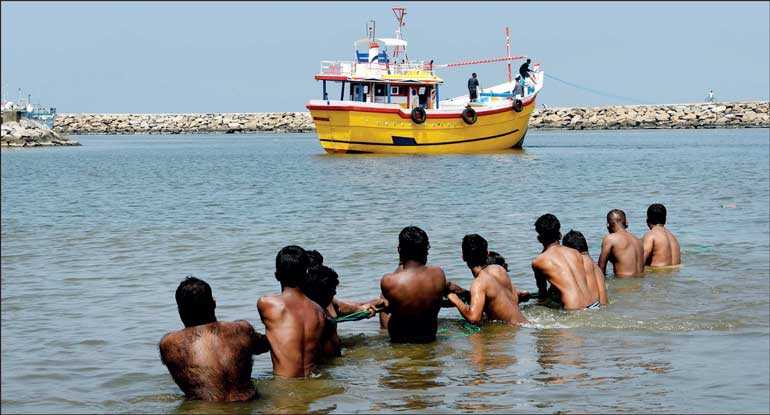Wednesday Mar 12, 2025
Wednesday Mar 12, 2025
Friday, 5 February 2021 00:00 - - {{hitsCtrl.values.hits}}

Our planet’s one ocean connects us all. Inadequate policy and insufficient efforts to safeguard the ocean’s natural capital that underpins our region’s economy and wellbeing and delivers trillions of dollars to the global economy have fallen short – Pic by Shehan Gunasekara
 “Unprecedented” might be judged the most used adjective of 2020, and too often for dire reasons. Yet the end of the year brought one more occasion to use the word, when the leaders of 14 countries put forward a new ocean action agenda underpinned by sustainably managing 100% of national waters. Asia-Pacific nations were well represented on the High Level Panel, by leaders of Australia, Fiji, Indonesia, Japan and Palau.
“Unprecedented” might be judged the most used adjective of 2020, and too often for dire reasons. Yet the end of the year brought one more occasion to use the word, when the leaders of 14 countries put forward a new ocean action agenda underpinned by sustainably managing 100% of national waters. Asia-Pacific nations were well represented on the High Level Panel, by leaders of Australia, Fiji, Indonesia, Japan and Palau.
This signals new or strengthened national policies that balance sustainable use of the ocean with the protection and restoration of the marine and coastal ecosystems so critical to our region for jobs, economic wellbeing, food and coastal protection. If fully implemented, December’s pledge could kick-start an unprecedented shift toward ocean management, which is so vital to consolidate a sustainable and prosperous future for generations of people and marine ecosystems.
There are five important measures that governments can do to achieve this.
Stop enabling overfishing
Overfishing remains one of the greatest threats to ocean health. It is fuelled by policy that enables overcapacity and overfishing combined with subsidies that distort the market. The consequences are clearly outlined in every report on declining fish stocks, and the World Bank has assessed that sustainable fisheries management generates more valuable catches with lower levels of fishing effort. But entrenched interests make it difficult for any nation to be the first to right-size its fleet.
Governments should set the course and support ecosystem-based fisheries management. It is an important solution that supports nutrition and health needs. In 2005, Australia has set a good example how to get there with a structural reform of its fisheries sectors. The “securing a sustainable fishing future” package put commonwealth managed fisheries on a path to economic and environmental sustainability with social safeguards to allow a reduction in fishing capacity without setting workers adrift.
There’s a real possibility to seize a competitive advantage by rechanneling harmful subsidies, such as fuel subsidies, into low-footprint aquaculture, especially plant-based.
Account for ocean assets
The total value of the ocean is estimated at $ 24 trillion, yet, it is suffers from severe underinvestment. In the last 10 years, only $ 13 billion has been invested in sustainable projects through philanthropy and official development assistance, and even less by the corporate sector. The goods and services the ocean provides our region are massively undervalued. For example, the significant benefits of coastal ecosystems such as coral reefs, coastal wetlands and mangrove forests that act as “natural buffers” to storms are rarely quantified and accounted for in coastal protection, which means hazard mitigation and budgetary decisions are being made without fully recognising their value.
We recommend creation of national ocean accounts to properly inform policymaking and resource management decisions. These ocean accounts should include not only what the ocean produces (like GDP), but also ocean income to account for benefits to people, and changes in ocean wealth, including ecosystems like coral reefs or fish populations, so to monitor sustainability.
Integrate policy frameworks
Policymakers must reject fragmented sector-based – and territorial – approaches that have failed and instead move towards fit-for-purpose governance, including policy and legislation. There are a few examples of large-scale integrated ocean management that work, such as the framework for the Great Barrier Reef Marine Park. However, there are promising frameworks under development, such as the National Oceans Policy legislation being developed for Fiji that integrates climate change, oceans and plastics or which have been recently agreed, such as the strategy for the sustainable development of the Vietnamese maritime economy.
There is also the growing recognition of the importance of local-level integrated policy frameworks being implemented across the region, such as in Fiji through Community-Based Integrated Land-Sea Management in Kubulau District, and in Japan’s Hinase area of Bizen City.
Integrated policy frameworks can extend to developing strategic plans to guide economic growth in an environmentally sound way and provide regulatory environments that build investor confidence and reduce delays to sustainable ocean projects. Key to the effectiveness and sustainability of all these measures, is that the policy development process is genuinely participatory and inclusive of communities, indigenous peoples, private sector and different parts of government, and based on science.
Use the full suite of policy instruments
In addition to necessary bans, rules and environmental standards, nations can employ market-based policy instruments. For example, mangrove forests are a natural solution for both mitigating climate change, due to their ability to sequester carbon, and adapting to its impacts on the coast, providing flood mitigation benefits worth billions at a global scale.
This sequestration potential for mangroves is particularly high in Indonesia, and Indonesia, Australia, Korea, Fiji and Papua New Guinea are all part of the International Partnership for Blue Carbon that seeks to promote and preserve the climate benefits of blue carbon ecosystems, including advice on how countries may include blue carbon in their Nationally Determined Contribution. Private sector incentives, such as blue bonds or reduced insurance premiums for investments in nature-based solutions like coral reef protection and restoration, are also promising.
To tackle the massive plastics crisis, and insidious nutrient pollution expanding ocean “dead zones” starved of oxygen and life, we need to discourage wasteful and polluting business models and behaviors by making them pay their fair share and instead incentivise green businesses. Countries such as India and Singapore are implementing market-based policy instruments to move towards a more circular economy where waste is ‘designed out’ and products and materials are kept in use for as long as possible.
Alappuzha, a coastal city in Kerala state, India, was once called “Venice of the East” until trash clogged its canals and drains. In 2014, the city addressed its growing waste problem by implementing a decentralised solid waste management system that includes educational subsidies for students to collect plastic waste and a penalty for illegal dumping of plastics. Singapore has a ‘towards zero waste’ commitment and will introduce policies to encourage sustainable production and consumption, with new initiatives including Extended Producer Responsibility, starting with electronic-waste in 2021.
Become an ocean-first region
Our planet’s one ocean connects us all. Inadequate policy and insufficient efforts to safeguard the ocean’s natural capital that underpins our region’s economy and wellbeing and delivers trillions of dollars to the global economy have fallen short.
The commitments of these 14 ocean leaders should be heard as the starter’s pistol for every other world leader. The race is on to deliver the most ambitious, future-focused sustainable blue economy strategic plan. ADB and WWF share a belief that Asia-Pacific can set the pace in this “race to restore.” Together, we will support a prosperous, inclusive, resilient and sustainable Asia-Pacific, and commit to working with the governments of the region to make that happen.
[Ingrid Van Wees is the Vice President, Asian Development Bank and John Tanzer is the World Wildlife Fund’s (WWF’s) Global Oceans Leader.]
Discover Kapruka, the leading online shopping platform in Sri Lanka, where you can conveniently send Gifts and Flowers to your loved ones for any event including Valentine ’s Day. Explore a wide range of popular Shopping Categories on Kapruka, including Toys, Groceries, Electronics, Birthday Cakes, Fruits, Chocolates, Flower Bouquets, Clothing, Watches, Lingerie, Gift Sets and Jewellery. Also if you’re interested in selling with Kapruka, Partner Central by Kapruka is the best solution to start with. Moreover, through Kapruka Global Shop, you can also enjoy the convenience of purchasing products from renowned platforms like Amazon and eBay and have them delivered to Sri Lanka.
Discover Kapruka, the leading online shopping platform in Sri Lanka, where you can conveniently send Gifts and Flowers to your loved ones for any event including Valentine ’s Day. Explore a wide range of popular Shopping Categories on Kapruka, including Toys, Groceries, Electronics, Birthday Cakes, Fruits, Chocolates, Flower Bouquets, Clothing, Watches, Lingerie, Gift Sets and Jewellery. Also if you’re interested in selling with Kapruka, Partner Central by Kapruka is the best solution to start with. Moreover, through Kapruka Global Shop, you can also enjoy the convenience of purchasing products from renowned platforms like Amazon and eBay and have them delivered to Sri Lanka.